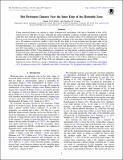| dc.contributor.author | Koll, Daniel | |
| dc.contributor.author | Cronin, Timothy Wallace | |
| dc.date.accessioned | 2020-04-17T16:07:03Z | |
| dc.date.available | 2020-04-17T16:07:03Z | |
| dc.date.issued | 2019-08 | |
| dc.date.submitted | 2019-07 | |
| dc.identifier.issn | 1538-4357 | |
| dc.identifier.issn | 0004-637X | |
| dc.identifier.uri | https://hdl.handle.net/1721.1/124725 | |
| dc.description.abstract | Young terrestrial planets can capture or outgas hydrogen-rich atmospheres with tens to hundreds of bars of H[subscript 2], which persist for 100 Myr or longer. Although the earliest habitable conditions on Earth and terrestrial exoplanets could thus arise while the atmosphere is still dominated by H[subscript 2], the climatic effects of H[subscript 2] remain poorly understood. Previous work showed that H[subscript 2] induces strong greenhouse warming at the outer edge of the habitable zone. Here we use a 1D radiative-convective model to show that H[subscript 2] also leads to strong warming near the inner edge of the habitable zone. Unlike H[subscript 2]'s greenhouse warming at the outer edge, however, its effect near the inner edge is driven by thermodynamics: H[subscript 2]'s large thermal scale height allows the atmosphere to store more water vapor than either a pure H[subscript 2]O atmosphere or an atmosphere with a heavy background gas, such as N[subscript 2] or CO[subscript 2], thereby amplifying the greenhouse effect of H[subscript 2]O. Using idealized gray calculations, we then present a general argument for how different background gases affect the inner edge of the habitable zone. H[subscript 2] stands out for its ability to induce novel "soufflé" climates, which further support its warming effect. Our results show that if the earliest conditions on a planet near the inner edge of the habitable zone were H[subscript 2]-rich, they were likely also hot: 1 bar of H[subscript 2] is sufficient to raise surface temperatures above 340 K, and 50 bar of H[subscript 2] are sufficient to raise surface temperatures above 450 K. | en_US |
| dc.description.sponsorship | National Science Foundation (U.S.) (Grant AGS-1623218) | en_US |
| dc.description.sponsorship | James S. McDonnell Foundation (Postdoctoral Fellowship) | en_US |
| dc.language.iso | en | |
| dc.publisher | American Astronomical Society | en_US |
| dc.relation.isversionof | http://dx.doi.org/10.3847/1538-4357/AB30C4 | en_US |
| dc.rights | Article is made available in accordance with the publisher's policy and may be subject to US copyright law. Please refer to the publisher's site for terms of use. | en_US |
| dc.source | The American Astronomical Society | en_US |
| dc.title | Hot Hydrogen Climates Near the Inner Edge of the Habitable Zone | en_US |
| dc.type | Article | en_US |
| dc.identifier.citation | Koll, Daniel D. B., and Timothy W. Cronin. “Hot Hydrogen Climates Near the Inner Edge of the Habitable Zone.” The Astrophysical Journal 881, 2 (August 2019): 120. © 2019 The American Astronomical Society. | en_US |
| dc.contributor.department | Massachusetts Institute of Technology. Department of Earth, Atmospheric, and Planetary Sciences | en_US |
| dc.relation.journal | Astrophysical Journal | en_US |
| dc.eprint.version | Final published version | en_US |
| dc.type.uri | http://purl.org/eprint/type/JournalArticle | en_US |
| eprint.status | http://purl.org/eprint/status/PeerReviewed | en_US |
| dc.date.updated | 2020-04-09T16:51:08Z | |
| dspace.date.submission | 2020-04-09T16:51:11Z | |
| mit.journal.volume | 881 | en_US |
| mit.journal.issue | 2 | en_US |
| mit.license | PUBLISHER_POLICY | |
| mit.metadata.status | Complete | |
